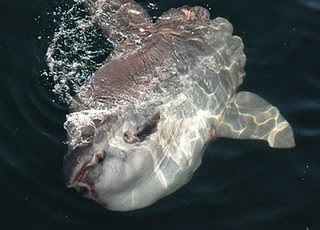NECWA Presents at the Cape Cod Natural History Conference



At today's conference, Krill and Nick presented their research on the ocean sunfish that stranded on Cape Cod beaches in 2008 and 2009. Ann also participated in a number of these examinations so was well versed when updating interested participants. The work being conducted by NECWA focuses on better understanding the stranding patterns of ocean sunfish in our area as well as their biology and internal anatomy.


Also at the NECWA table was material on NEBShark (the New England Basking Shark Project), NECWA's community sighting network for both ocean sunfish and basking sharks. And NECWA provided a number of educational displays that included ocean sunfish bones and prey items including copepods, a favorite food of the basking shark.

Many conference participants stopped by the table to read the ocean sunfish poster, learn how they can report sightings to NEBShark and to chat with Krill, Ann and Nick. But by and large, folks were most interested in the ocean sunfish bones on display. Although ocean sunfish are classified as the heaviest bony fish in the world, their bones are more similar to the cartilaginous bones of sharks, skates and rays.

But if anything rings true about the ocean sunfish, it is that this pelagic fish is odd from many perspectives. The research that NECWA is conducting on this species is helping biologists better understand this odd marine animal that is an ocean wanderer as it seeks out its favorite prey, jellyfish!

Below is the abstract for NECWA's poster on Stranded Ocean Sunfish along the shores of Cape Cod Bay for 2008 and 2009.
Title: Ocean Sunfish, Mola mola, Stranding and Necropsy Information, 2008 and 2009.
The ocean sunfish, Mola mola, is the heaviest bony fish in the world and has a very odd appearance as it lacks a true caudal (tail) fin. Sunfish observed off Cape Cod are typically 6 to 10 feet in length and weigh between 200 – 1000 pounds. Sunfish migrate to the waters of Cape Cod Bay and Massachusetts Bay to feed on jellyfish, ctenophores and other gelationous animals abundant in cold waters. In the fall of 2008 and 2009, staff from the New England Coastal Wildlife Alliance (NECWA), Wellfleet Bay Wildlife Sanctuary, Cape Cod Consultants, NEBShark volunteers and others responded to reports of over 25 ocean sunfish that stranded alive or dead on the shores of Cape Cod Bay.
The majority of stranding reports of ocean sunfish were sent to the New England Basking Shark Project (NEBShark), a community network maintained by NECWA. In the fall of 2008, 5 ocean sunfish were reported stranded with only 1 individual stranding alive. This individual died shortly after stranding. In 2009, over 16 ocean sunfish were reported stranded with only 1 indivudual stranding alive. A rescue attempt was made for this individual, but the fish died during the rescue attempt.
In 2008 and 2009, NECWA staff and collaborators were able to collect external body measurements and photographs on many of the carcasses reported during both years. For carcasses that were fresh or recently exposed, NECWA staff were able to conduct necropsies or animal autopsies in an attempt to better understand the internal anatomy of this species. In 2008, 3 carcasses were necropsied and in 2009, 4 carcasses were necropsied. The poster that NECWA presented reviewed the data collected from these external and internal examinations.
In 2009 a focus was placed on determining the age of ocean sunfish that strand on Cape Cod beaches. Fisheries biologists typicaly examine the otoliths of bony fish in order to determine the age of the individual. Otoliths are calcified structures in the inner ear channels of bony fish that help the fish maintain balance and position in the water column. Given the large size of the ocean sunfish, it was hoped that the otoliths of this species could be used for this analysis.
NECWA staff and collaborators collected otoliths from a number of stranded individuals. With the help of scientists from Harvard’s Museum of Comparative Zoology, it was discovered that the otoliths of ocean sunfish are not appropriate for age determination studies due to their small size and grainy composition. Focus is now shifted to the vertebrae of the sunfish in the hope that this species can be aged using similar techniques that is successful for cartilaginous fish, like sharks and skates.



Comments
Post a Comment